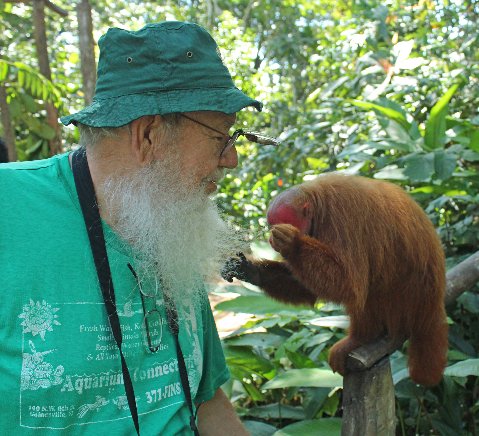Excitement was palpable. We left Iquitos, Peru, at 0800 that morning and then, 12 hours later, we were nearing our destination.
Segundo Rios, our captain, eased back on the throttle of the Tucanare (our river boat), and almost imperceptably the boat nosed against the shoreline. We had arrived at Madre Selva Biological Preserve on the west bank of the Rio Orosa, our home for the next 10 days; ten days of around the clock tropical herping.
We had eaten on the boat and everyone was ready for at least a short introductory night walk so as soon as we had all located our tambos (screened individual rooms).

I elected to take the group along the short trail, a wonderful loop of herp habitat. Once again, I instructed all of the absolute need to watch carefully for fer-de-lance and to remember that rhyme of "red to yellow kill a fellow and red to black venom lack" did
not apply to any of the several species of coral snakes we might encounter.
Even before we had gotten out of the biological station's clearing, we had found several species of lizard (anoles and geckos), an auspicious beginning to a wonderful and educational trip. Fifty yards down the trail C-sar commented, "Snake, Imantodes." He had spotted a blunt-headed tree snake,
Imantodes cenchoa, in a trailside bush.
Flashlight beams were quickly brought to bear on the little snake of vine-like slenderness, and the popping of camera flashes brought to mind a mini lightning storm.
When all had taken what they felt were sufficient photos we moved on. Broad-headed treefrogs (
Osteocephalus sp.) and an occasional monkey frog (
Phyllomedusa sp.) vocalized from bromeliads high overhead, but none were seen than night.

However, crested forest toads,
Bufo margaritifera, were numerous along the trail, and some were seen three feet above ground on flat-leafed plants.
"What kind of lizard is this?" someone asked. Ah ha! The guides had walked by (and they don't often miss much!) a foot long green forest dragon,
Enyalioides laticeps, sleeping quietly on a horizontal limb 8 feet above ground. Again, a pause for photos and we continued.
The guides didn't miss the next herp though. This was a hatchling aquatic coral snake,
Micrurus s. surinamensis, foraging in a tiny mud bottomed rivulet. Pictures again, at first in situ and then the snake was carefully hooked out for closeups. And all too soon, we were back at camp.

This proved to be a great trip, though, for in the next nine days the group found and photographed about 110 species of reptiles and amphibians, as well as taking additional pictures to document what was for most participants their very first Amazon adventure. It is wonderful to be able to experience the joy of each new group on what for many is the trip of a lifetime.
 Author, photographer, and columnist Richard Bartlett is one of the most prolific writers on herpetological subjects in the 20th century. With hundreds of books and articles to their credit, Richard and his wife Pat have spent over four decades documenting reptiles both in the field and in captivity. For a list of their current titles, please visit their page in our bookstore. Author, photographer, and columnist Richard Bartlett is one of the most prolific writers on herpetological subjects in the 20th century. With hundreds of books and articles to their credit, Richard and his wife Pat have spent over four decades documenting reptiles both in the field and in captivity. For a list of their current titles, please visit their page in our bookstore. |




To prevent automated Bots from commentspamming, please enter the string you see in the image below in the appropriate input box. Your comment will only be submitted if the strings match. Please ensure that your browser supports and accepts cookies, or your comment cannot be verified correctly.